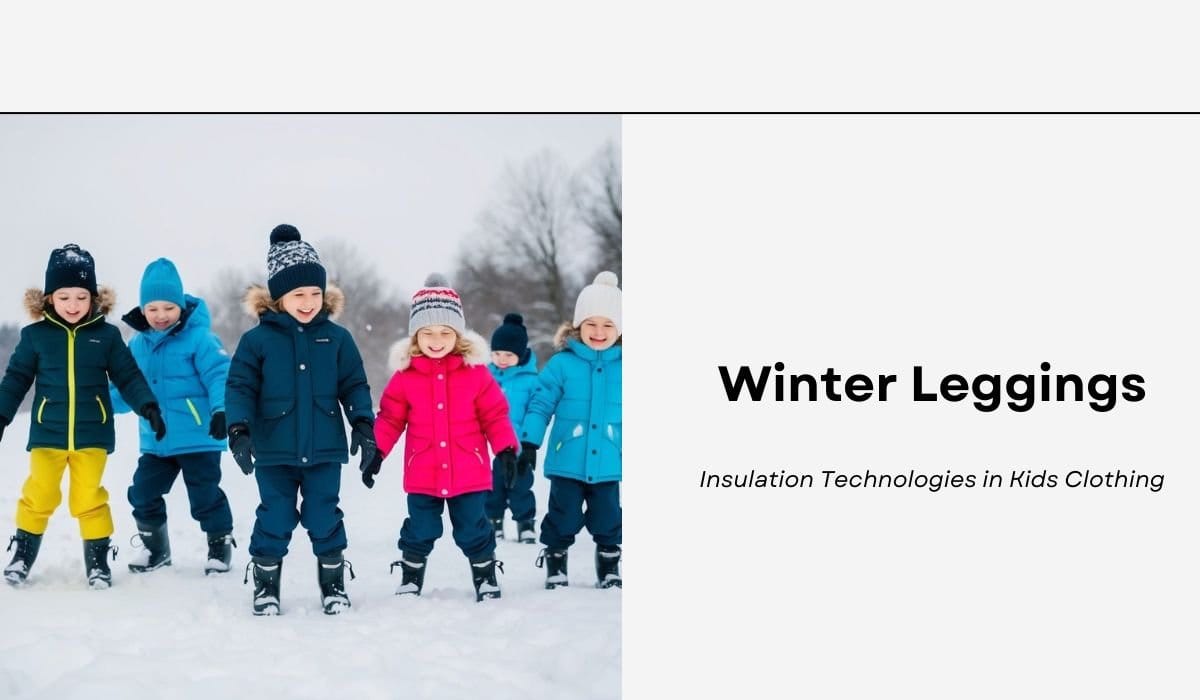Understanding Modern Warmth – A Deep Dive into the Science Keeping Little Children Cosy
Winter leggings have become a vital part of children’s cold-weather wardrobes. These snug-fitting garments provide essential warmth and comfort for active kids during chilly months. Modern insulation technologies in winter leggings for children offer superior heat retention without adding bulk, allowing for easy movement and layering.
Many brands now use advanced fabrics and designs to create thermal leggings that keep little ones cosy in various conditions. These leggings often feature moisture-wicking properties to keep skin dry during outdoor play. Some even incorporate water-resistant elements for added protection in wet weather.
Parents can find a wide range of options to suit different needs and preferences. From basic thermal layers to fleece-lined styles, there’s a perfect pair for every child and activity. Proper sizing and fit are crucial to ensure maximum effectiveness and comfort.
On This Page
Key Takeaways
- Thermal leggings provide essential warmth for children without restricting movement
- Advanced fabrics offer superior insulation, moisture management, and sometimes water resistance
- Proper fit and layering are key to maximising the effectiveness of winter leggings for kids
Evolution of Kids’ Thermal Leggings
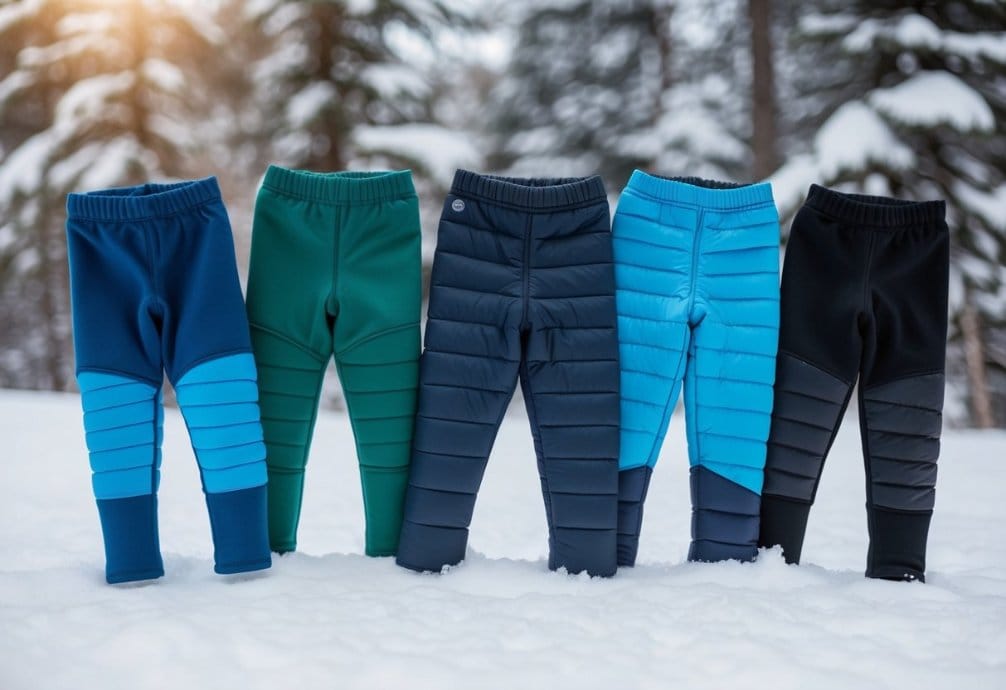
Thermal leggings for children have changed a lot over time. New materials and designs keep kids warmer and more comfortable in cold weather.
History and Advances in Insulation Technologies
Early thermal leggings for kids were thick and bulky. They used heavy cotton or wool to trap heat. In the 1970s, synthetic fabrics like polyester came into use. These were lighter but still warm.
The 1990s saw big improvements. Brands made leggings with special insulating layers. Some used hollow fibres to trap more warm air. Others added thin metallic coatings to reflect body heat.
Today’s thermal leggings use smart fabrics. Some change shape to keep more heat when it’s cold. Others move sweat away from the skin to keep kids dry. Many combine different materials for the best warmth and comfort.
The Rise of Thermal Leggings in Children’s Fashion
Thermal leggings became popular for kids in the 1980s. At first, they were just for outdoor activities like skiing. Parents liked that they kept children warm without adding bulk.
In the 2000s, thermal leggings became everyday wear. Brands made them in fun colours and patterns. This made them nice to look at, not just practical. Kids started wearing them for play and school, not just sports.
Now, thermal leggings are a winter staple for many children. They come in different styles to suit all tastes. Some look like normal leggings but have hidden warm layers. Others have cosy fleece linings. Prices range from cheap to high-end, so most families can find a pair that fits their budget.
Understanding the Materials
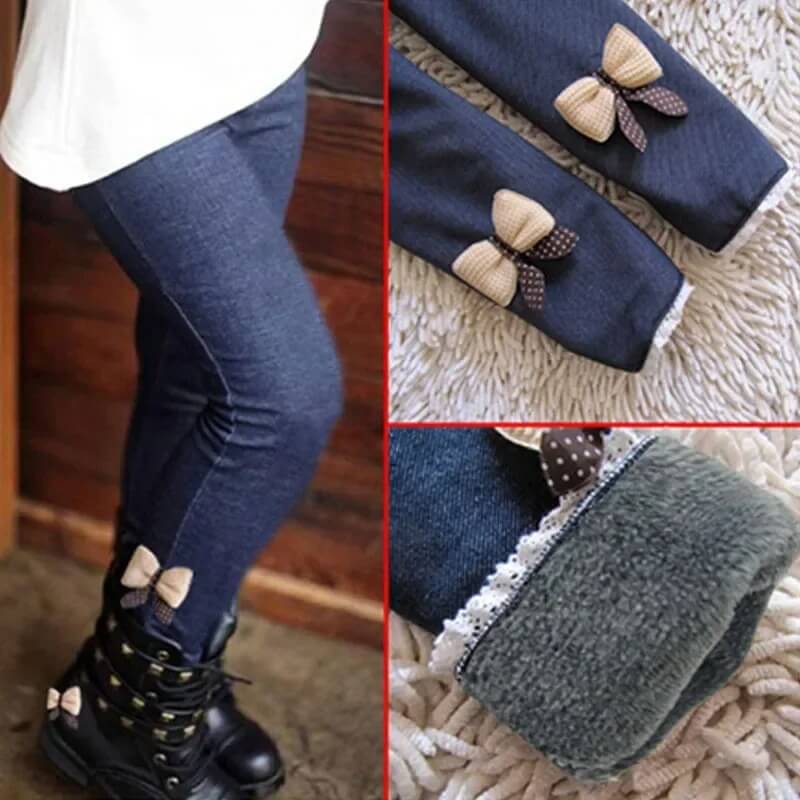
Winter leggings for kids rely on specific materials to provide warmth and comfort. Polyester and merino wool are two popular options that offer unique benefits for cold-weather wear.
Key Properties of Polyester and Merino Wool
Polyester is a synthetic fibre known for its durability and moisture-wicking abilities. It dries quickly, making it ideal for active children. Polyester leggings often feature a brushed interior for added warmth and softness against the skin.
Merino wool, a natural fibre, excels at temperature regulation. It can absorb up to 30% of its weight in moisture without feeling damp. Merino wool leggings are soft, breathable, and naturally odour-resistant.
Both materials offer good insulation, helping to trap warm air close to the body. This trapped air acts as a barrier against the cold, keeping kids cosy during winter activities.
Comparison of Synthetic and Natural Fibres
Synthetic fibres like polyester are often more affordable and easier to care for than natural options. They resist wrinkles and maintain their shape well after repeated wear and washing.
Natural fibres such as merino wool tend to be more expensive but offer superior warmth-to-weight ratio. They’re biodegradable and often preferred by those seeking eco-friendly options.
Polyester is generally more durable and resistant to wear and tear. Merino wool, while less durable, offers better temperature regulation and moisture management.
When choosing between synthetic and natural fibres for kids’ winter leggings, consider factors like climate, activity level, and personal preferences for comfort and care.
Design and Functionality
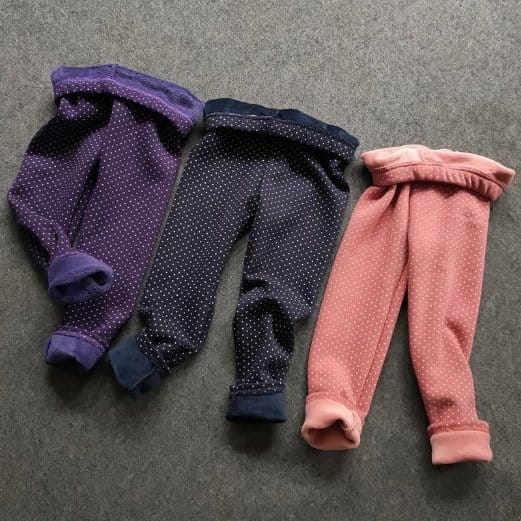
Winter leggings for kids blend form and function to keep children warm and comfortable. Key features include UV protection and sweat-wicking properties to enhance performance in cold weather.
Incorporating UV Protection into Kids’ Leggings
UV protection in winter leggings shields children’s skin from harmful sun rays, even on cold days. Manufacturers add special fibres or treatments to the fabric to block UV radiation. This feature is crucial for outdoor winter activities like skiing or sledging.
Some leggings use zinc oxide or titanium dioxide particles embedded in the fabric. These tiny particles reflect and scatter UV rays. Other brands incorporate UV-absorbing chemicals into the textile fibres.
The level of UV protection is measured by the Ultraviolet Protection Factor (UPF). Leggings with a UPF of 50+ block over 98% of UV rays. This rating is ideal for kids’ winter wear.
The Importance of Sweat-Wicking Features
Sweat-wicking technology keeps kids dry and warm during active play in cold weather. This feature moves moisture away from the skin to the outer layer of the fabric.
Synthetic fibres like polyester and nylon are common in sweat-wicking leggings. These materials don’t absorb water, allowing sweat to pass through quickly. Some brands use special weaves or treatments to enhance moisture movement.
Sweat-wicking leggings help regulate body temperature. They prevent the clammy feeling of damp clothes against skin. This is vital for kids who might not notice they’re getting too cold or wet while playing.
Natural fibres like merino wool also offer sweat-wicking properties. They can absorb moisture while still keeping kids warm.
Layering for Optimal Warmth
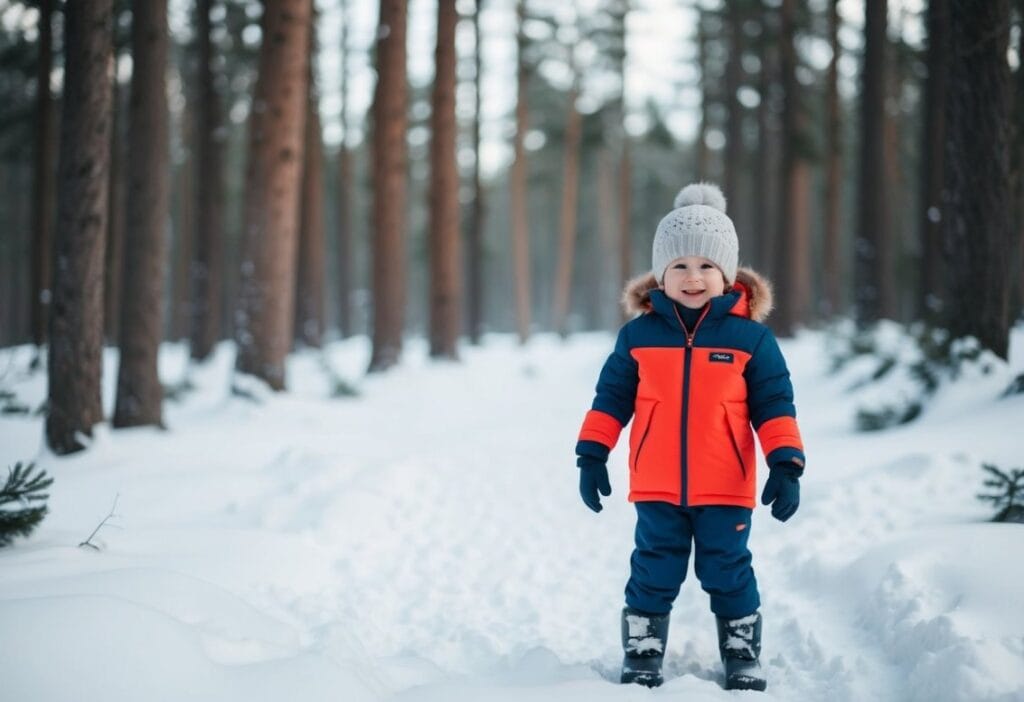
Proper layering is key to keeping kids warm in cold weather. It traps heat and allows for easy adjustments as activity levels change.
Choosing the Right Base Layer for Your Child
The base layer sits next to the skin. It should be snug but not tight. Merino wool is an excellent choice. It’s warm, breathable, and naturally odour-resistant.
Synthetic fabrics like polyester also work well. They wick sweat away from the body to keep kids dry. Avoid cotton as a base layer. It absorbs moisture and stays damp.
For very cold days, thermal tops and leggings provide extra warmth. Look for options with a bit of stretch for comfort during play.
How to Effectively Layer Thermal Gear
Start with the base layer. Add a middle layer for insulation. This could be a fleece jumper or light puffy jacket. The outer layer should be waterproof and windproof.
Adjust layers based on activity. Remove the middle layer if kids get too warm while playing. Add it back on for less active times.
Don’t forget extras like hats, gloves, and warm socks. A neck warmer can help seal out cold air.
Remember to dress kids a bit cooler than you might dress yourself. They often generate more heat when active.
A Spectrum of Choices
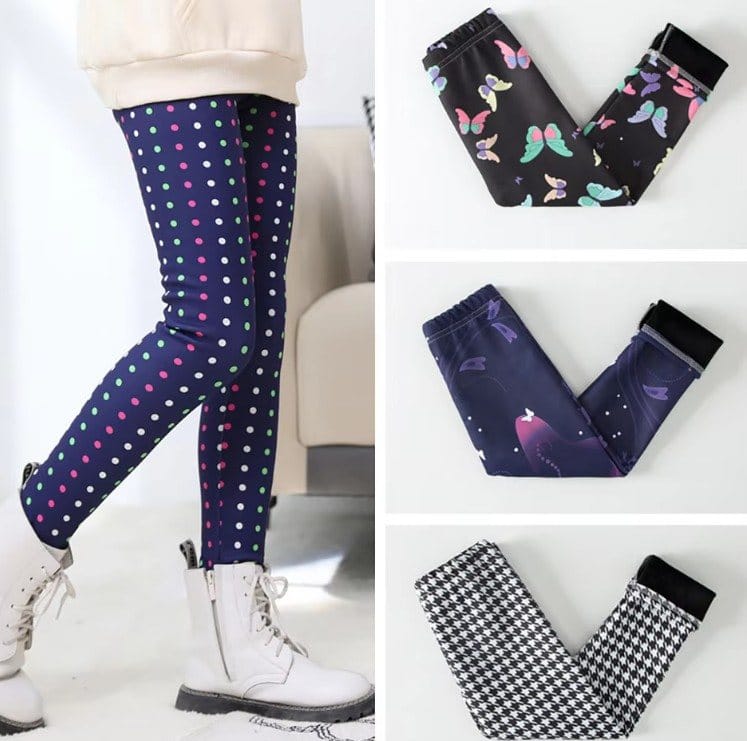
Winter leggings for kids offer more than just warmth. Colours and patterns play a big role in making them fun and stylish. Parents and children can pick from many options to suit different tastes.
From Monochrome to a Palette of 3 Colours
Plain white leggings are a classic choice for winter. They go well with any outfit and look clean and crisp. But kids often want more exciting options.
Many brands now make leggings in sets of three colours. This gives kids more ways to mix and match their clothes. A typical set might have white, grey, and black leggings. Or it could have bright colours like red, blue, and green.
Some leggings have patterns too. Stripes, dots, and fun prints are popular. These add flair to winter outfits without losing warmth.
Picking colours can be fun for kids. It lets them show their style. Bright colours can make dreary winter days feel more cheery. Dark colours are good for hiding dirt from outdoor play.
Size and Fit for Children
Proper sizing and fit are crucial for kids’ winter leggings. Well-fitted thermal leggings keep children warm and comfortable during cold weather activities.
Ensuring a Comfortable and Secure Fit for Kids
When choosing thermal leggings for kids, focus on the right size and length. Measure the child’s waist and inseam for the best fit. Look for leggings with elastic waistbands and adjustable drawstrings to accommodate growth.
Consider the fabric blend. A mix of cotton and synthetic fibres offers comfort and flexibility. Avoid leggings that are too tight, as they can restrict movement and be uncomfortable.
Check the length of the leggings. They should reach the ankle without bunching or being too short. Some brands offer different length options for varied heights.
Try leggings on before buying if possible. Have the child move around to ensure a good fit during activity. Look for reinforced knees and seamless designs to prevent chafing and increase durability.
Remember that kids grow quickly. Consider buying a slightly larger size for longer wear, but not so large that the leggings are baggy or unsafe.
The Role of British Retailers
British retailers play a key part in providing winter leggings for kids. They offer a range of options to keep children warm during cold months. Two companies stand out for their contributions to this market.
Mountain Warehouse and Baselayar Ltd’s Contributions
Mountain Warehouse is a major UK outdoor retailer. They sell thermal leggings for children as part of their winter range. These leggings use special fabrics to trap heat close to the skin.
Baselayar Ltd is a UK-based company that focuses on base layers. They make thermal leggings for kids using merino wool. This natural fibre helps regulate body temperature. Baselayar Ltd sells their products directly to customers. They also supply other UK retailers.
Pertemba GB’s Distribution within the UK
Pertemba GB is a big player in UK clothing distribution. They work with many brands to bring winter leggings to shops across the country. Pertemba GB helps get products from makers to sellers quickly.
They stock a wide range of kids’ thermal leggings. These include both budget-friendly and high-end options. Pertemba GB’s network allows small shops to offer the same choices as large chains. This helps ensure children all over the UK can access warm winter gear.
Shopping Guide
Finding great deals on quality thermal leggings for kids can be tricky. New styles and technologies are constantly hitting the market too. Let’s explore some tips for smart shopping.
Finding Quality Thermal Leggings on Sale
Look for end-of-season sales at major retailers to snag bargains on thermal leggings. Many shops offer deep discounts in late winter to clear out stock.
Online marketplaces often have flash sales with big markdowns. Set up price alerts to catch these deals.
Compare prices across different sites before buying. Some places may price match competitors.
Check outlet stores and discount chains for last season’s styles at lower prices. The insulation tech is usually just as good.
Buy multipacks or bundles to save. Many shops offer 2-3 pairs together at a reduced rate per item.
What’s New in the Market for Your Young Ones
Brands are using more eco-friendly materials in kids’ thermal leggings. Look for options made from recycled plastics or organic fibres.
New moisture-wicking fabrics help keep kids dry and comfy during active play. Some even have odour-control properties.
Leggings with built-in UV protection are great for winter sports. They shield delicate skin from the sun’s rays.
Fun prints and colours are all the rage. Think unicorns, dinosaurs, and bold geometric patterns that kids love.
Some newer styles have reinforced knees and seats. This helps them last longer through rough and tumble play.
Care and Maintenance
Proper care of thermal leggings helps them last longer and perform better. Good habits keep kids warm and cosy all winter.
Prolonging the Life of Thermal Leggings
To make thermal leggings last, rotate between multiple pairs. This gives each pair time to rest and regain shape between uses. Avoid rough surfaces that could snag or wear down the fabric.
Store leggings folded neatly in drawers. Don’t hang them, as this can stretch out the waistband. Keep them away from direct sunlight to prevent fading.
Check for loose threads or small holes often. Mend these quickly to stop them from getting bigger. Use a fabric shaver to remove pilling and keep leggings looking new.
Washing and Drying Best Practices
Always check the care label first. Most thermal leggings need gentle washing in cold water. Use a mild detergent and avoid fabric softeners, which can harm the insulating properties.
Turn leggings inside out before washing to protect the outer surface. Wash similar colours together to prevent dye transfer.
Avoid tumble drying if possible. Air drying is best for most thermal fabrics. Lay leggings flat to dry, away from direct heat sources. This helps them keep their shape.
If you must use a dryer, use the lowest heat setting. Remove promptly and smooth out wrinkles by hand.
Complementary Accessories
Pairing winter leggings with the right accessories creates a warm, stylish outfit for kids. The right gloves, joggers, and trousers can enhance comfort and protection from the cold.
Coordinating Gloves and Joggers with Leggings
Gloves are essential for keeping little hands toasty. Look for waterproof options with good insulation. Fleece-lined gloves offer extra warmth. For active kids, choose gloves with grips on the palms.
Joggers can be layered over leggings on extra cold days. Opt for fleece-lined joggers for maximum warmth. Some joggers have elastic cuffs to keep out draughts.
Many brands offer matching sets of leggings, gloves, and joggers. These coordinated outfits make getting dressed easier. They also ensure all pieces work well together for a cohesive look.
Complete the Ensemble with Thermal Trousers
Thermal trousers are a great addition to a winter wardrobe. They can be worn over leggings for added warmth. Look for trousers made from insulating materials like fleece or wool.
Some thermal trousers have a water-resistant outer layer. This helps keep kids dry in snow or light rain. Adjustable waistbands ensure a good fit as children grow.
For maximum cosiness, choose trousers with a soft, brushed inner lining. This feels nice against the skin and traps warm air. Reinforced knees and seats add durability for active play.
Frequently Asked Questions
Parents often have questions about thermal leggings for children. These answers cover key topics like materials, layering, temperature guidelines, and design differences.
What materials are used in the fabrication of thermal leggings for children?
Thermal leggings for kids are made from insulating fabrics. Common materials include synthetic blends with polyester and spandex. Some use merino wool for natural warmth. Many thermal leggings have moisture-wicking properties to keep children dry.
How should thermal tights be layered with other clothing for optimal warmth in winter?
Thermal tights work best as a base layer. Put them on first, then add trousers or skirts on top. For extra cold days, wear thick socks over the tights. A warm jumper or coat completes the outfit.
At what temperatures should children start wearing thermal leggings?
Most children benefit from thermal leggings when temperatures drop below 10°C. For active kids, 5°C might be the tipping point. Consider wind chill and how long they’ll be outside when deciding.
What distinguishes thermal tights from regular leggings in terms of insulation properties?
Thermal tights have special insulation built into the fabric. They trap warm air close to the skin. Regular leggings are thinner and lack this warming technology. Thermal options often have a brushed inner layer for extra cosiness.
Are there specific thermal leggings recommended for school uniforms?
Many schools allow plain, dark-coloured thermal leggings under uniforms. Look for navy, grey, or black options without patterns. Some brands make leggings designed to blend with school clothes. Check your school’s dress code first.
How do thermal leggings for girls differ in design and function?
Girls’ thermal leggings often come in more colours and patterns. They might have extra stretch for activities like dance. Some styles include skirts attached for a layered look. The basic warming function is the same as boys’ versions.
Related Post: Insulated vs. Non-Insulated Leggings: Choosing the Right Pair for Your Workout

